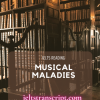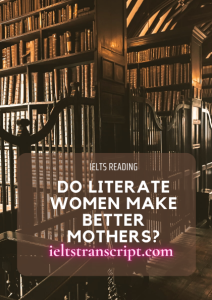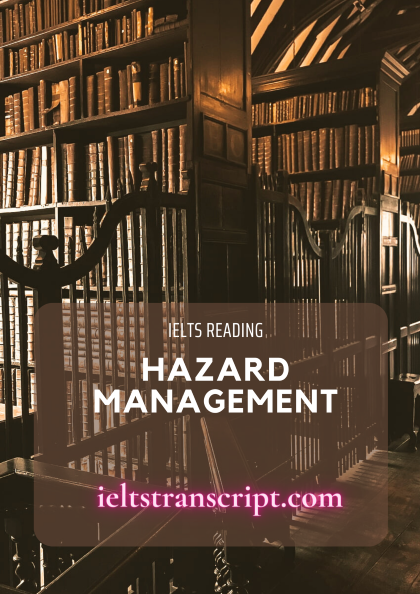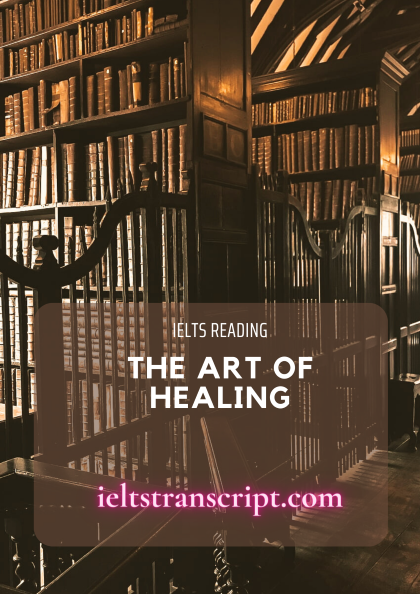- Đối với sản phẩm có giá: Sau khi chúng tôi ghi nhận thông tin đã thanh toán sản phẩm của bạn, sản phẩm sẽ được mở khóa và bạn có thể xem trực tiếp và tải tài liệu sản phẩm.
- Đối với thành viên trả phí: Bạn có thể mua và thanh toán sản phẩm với giá 0đ để tải tài liệu sản phẩm.
- Bạn có thể liên hệ với chúng tôi để được hỗ trợ mở khóa sản phẩm sớm nhất.
DO LITERATE WOMEN MAKE BETTER MOTHERS?
- Chúng tôi chấp nhận các phương thức thanh toán sau đây: Thẻ tín dụng, thẻ ghi nợ, PayPal, chuyển khoản ngân hàng và tiền mặt.
Chúng tôi sẽ không thu thêm phí cho bất kỳ hình thức thanh toán nào.
- Nếu bạn gặp vấn đề về sản phẩm của chúng tôi trong thời gian sử dụng, vui lòng liên hệ với chúng tôi để được hỗ trợ xử lý sớm nhất nhé.
Xem trước mẫu
Do literate women make better mothers?
Children in developing countries are healthier and more likely to survive past the age of five when their mothers can read and write. Experts In public health accepted this idea decades ago, but until now no one has been able to show that a woman’s ability to read in Itself Improves her children’s chances of survival.
Most literate women learnt to read In primary school, and the fact that a woman has had an education may simply indicate her family’s wealth or that It values Its children more highly. Now a long-term study carried out In Nicaragua has eliminated these factors by showing that teaching reading to poor adult women, who would otherwise have remained Illiterate, has a direct effect on their children’s health and survival.
In 1979, the government of Nicaragua established a number of social programmes, including a National Literacy Crusade. By 1985, about 300,000 Illiterate adults from all over the country, many of whom had never attended primary school, had learnt how to read, write and use numbers.
During this period, researchers from the Liverpool School of Tropical Medicine, the Central American Institute of Health In Nicaragua, the National Autonomous University of Nicaragua and the Costa Rican Institute of Health Interviewed nearly 3,000 women, some of whom had learnt to read as children, some during the literacy crusade and some who had never learnt at all. The women were asked how many children they had given birth to and how many of them had died In Infancy. The research teams also examined the surviving children to find out how well-nourished they were.
The Investigators’ findings were striking. In the late 1970s, the infant mortality rate for the children of Illiterate mothers was around 110 deaths per thousand live births. At this point In their lives, those mothers who later went on to learn to read had a similar level Of child mortality (105/1000). For women educated in primary school, however, the Infant mortality rate was significantly lower, at 80 per thousand.
In 1985, after the National Literacy Crusade had ended, the infant mortality figures for those who remained illiterate and for those educated In primary school remained more or less unchanged. For those women who learnt to read through the campaign, the infant mortality rate was 84 per thousand, an impressive 21 points lower than for those women who were still Illiterate. The children of the newly-literate mothers were also better nourished than those of women who could not read.
Why are the children of literate mothers better off? According to Peter Sandiford of the Liverpool School of Tropical Medicine, no one Knows for certain. Child health was not on the curriculum during the women’s lessons, so fie and his colleagues are looking at other factors. They are working with the same group of 3,000 women, to try to find out whether reading mothers make better use of hospitals and clinics, opt for smaller families, exert more control at home, learn modern childcare techniques more quickly, or whether they merely have more respect for themselves and their children.
The Nicaraguan study may have important implications for governments and aid agencies that need to know where to direct their resources. Sandiford says that there is increasing evidence that female education, at any age, is “an important health intervention in its own right’. The results of the study lend support to the World Bank’s recommendation that education budgets in developing countries should be increased, not just to help their economies, but also to improve child health.
‘We’ve known for a long time that maternal education is important,’ says John Cleland of the London School of Hygiene and Tropical Medicine. ‘But we thought that even if we started educating girls today, we’d have to wait a generation for the pay off. The Nicaraguan study suggests we may be able to bypass that.’
Cleland warns that the Nicaraguan crusade was special in many
...Phụ nữ biết chữ có làm mẹ tốt hơn không?
Trẻ em ở các nước đang phát triển khỏe mạnh hơn và có nhiều khả năng sống sót qua năm tuổi hơn khi mẹ của các em biết đọc và viết. Các chuyên gia y tế cộng đồng đã chấp nhận quan điểm này từ nhiều thập kỷ trước, nhưng đến nay vẫn chưa ai có thể chứng minh rằng khả năng đọc của phụ nữ thực sự giúp cải thiện cơ hội sống sót của con mình.
Hầu hết phụ nữ biết chữ đã học đọc ở trường tiểu học, và việc một phụ nữ được học hành có thể chỉ đơn giản cho thấy sự giàu có của gia đình hoặc họ trân trọng con cái của mình hơn. Giờ đây, một nghiên cứu dài hạn được thực hiện ở Nicaragua đã loại bỏ những yếu tố này khi chỉ ra rằng việc dạy đọc cho phụ nữ nghèo trưởng thành – những người mà lẽ ra vẫn sẽ mù chữ, có ảnh hưởng trực tiếp đến sức khỏe và sự sống còn của con họ.
Năm 1979, chính phủ Nicaragua đã thiết lập một số chương trình xã hội, bao gồm cả Chiến dịch xóa mù chữ quốc gia. Đến năm 1985, khoảng 300.000 người mù chữ trên khắp đất nước, trong đó có nhiều người chưa bao giờ học tiểu học, đã được học cách đọc, viết và sử dụng các con số.
Trong thời kỳ này, các nhà nghiên cứu từ Trường Y học Nhiệt đới Liverpool, Viện Y tế Trung Mỹ ở Nicaragua, Đại học Tự chủ Quốc gia Nicaragua và Viện Y tế Costa Rica đã phỏng vấn gần 3.000 phụ nữ, một số đã học đọc khi còn nhỏ, một số được học từ chiến dịch xóa mù chữ, và một số chưa bao giờ học gì cả. Những người phụ nữ được hỏi rằng đã sinh bao nhiêu con, và bao nhiêu trong số đó đã chết trong giai đoạn sơ sinh. Các nhóm nghiên cứu cũng kiểm chứng những đứa trẻ sống sót để tìm hiểu xem chúng được nuôi dưỡng tốt như thế nào.
Kết quả của các điều tra viên đã gây ấn tượng mạnh. Vào cuối những năm 1970, tỷ lệ tử vong ở tuổi sơ sinh đối với con của các bà mẹ mù chữ là khoảng 110 ca tử vong trên một nghìn ca sinh. Tại thời điểm này trong đời, những bà mẹ tiếp tục học đọc vẫn phải chịu tỷ lệ tử vong tương tự với con mình (105/1000). Tuy nhiên, đối với phụ nữ học tiểu học, tỷ lệ này thấp hơn đáng kể, ở mức 80 phần nghìn.
Năm 1985, sau khi Chiến dịch chinh xóa mù chữ quốc gia kết thúc, số liệu tử vong ở trẻ sơ sinh của những bà mẹ vẫn chưa biết chữ và đối với những bà mẹ được học tiểu học ít nhiều không thay đổi. Đối với những phụ nữ học đọc thông qua chiến dịch, tỷ lệ đứa con sơ sinh của họ bị tử vong là 84 phần nghìn, thấp hơn đến 21 điểm so với những phụ nữ vẫn còn mù chữ. Con cái của những bà mẹ mới biết chữ cũng được nuôi dưỡng tốt hơn những đứa con của các người mẹ không biết đọc.
Tại sao con cái của những bà mẹ biết chữ lại sống tốt hơn? Theo Peter Sandiford của Trường Y học Nhiệt đới Liverpool, không ai biết chắc chắn câu trả lời. Sức khỏe trẻ em không có trong chương trình giảng dạy trong các giờ học dành cho phụ nữ, vì vậy Peter và các đồng nghiệp của mình đang xem xét các yếu tố khác. Họ đang làm việc với cùng một nhóm 3.000 phụ nữ, để cố gắng tìm hiểu xem liệu các bà mẹ biết đọc có tận dụng tốt hơn các bệnh viện và phòng khám, liệu họ có lựa chọn sinh ít hơn, kiểm soát nhiều hơn ở nhà, học các kỹ thuật chăm sóc trẻ hiện đại nhanh hơn, hay liệu họ chỉ đơn thuần có tôn trọng hơn đối với bản thân và con cái của họ.
Nghiên cứu ở Nicaragua có thể mang ý nghĩa quan trọng đối với các chính phủ và các cơ quan viện trợ nào đang cần tìm nơi để điều động nguồn lực của họ. Sandiford nói rằng ngày càng có nhiều bằng chứng cho thấy giáo dục phụ nữ, ở mọi lứa tuổi, là “một biện pháp can thiệp sức khỏe quan trọng theo đúng nghĩa của nó”. Kết quả của nghiên cứu đã củng cố cho khuyến nghị của Ngân hàng Thế giới rằng nên tăng ngân sách giáo dục ở các nước đang phát triển, không chỉ để giúp nền kinh tế của họ mà còn để cải thiện sức khỏe trẻ em.
John Cleland thuộc Trường Vệ sinh và Y học Nhiệt đới London cho biết: “Từ lâu chúng tôi đã biết rằng giáo dục cho các bà mẹ là quan trọng. Nhưng chúng tôi đã nghĩ rằng ngay cả khi đã bắt đầu giáo dục trẻ em gái ngày nay, chúng tôi sẽ phải đợi một thế hệ mới nhận được kết quả. Nghiên cứu ở Nicaragua cho thấy chúng ta có thể vượt qua điều
...Để xem được đầy đủ nội dung và tải dữ liệu, bạn phải trở thành thành viên của chúng tôi và trả phí cho tài liệu (nếu có)











